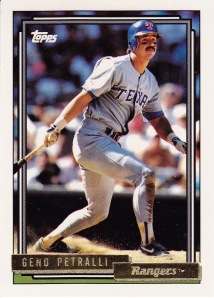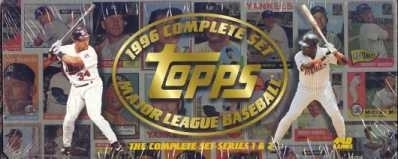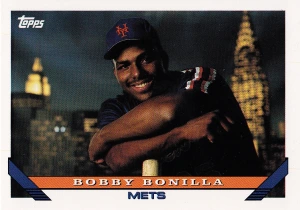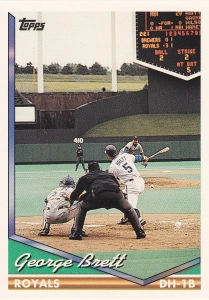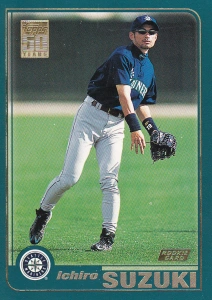The decade of the 1990s was a unique one it the history of baseball. Unfortunately, many of the biggest stories of the decade were of the negative variety. This decade will forever be known for 1994, when baseball’s couldn’t overcome it’s labor issues, and the World Series was canceled for the first time since 1904 (when the Series was in its second year). John McGraw and Donald Fehr – the two men who have led the cancellation of the World Series.
The decade started with the Reds, fresh off the lifetime ban of their manager, sweeping the heavily favored Oakland A’s. The A’s had been viewed as a potential dynasty at the end of the 1980’s, but now the Bash Brothers are remembered more for their negative impact on the game. Mark McGwire would move from Oakland to St. Louis, where he gained fame, along with Sammy Sosa, for the great chase of Roger Maris in 1998. But today we remember him and fellow Oakland teammate Jose Canseco for being the start of the steroids era.
The 1990’s saw baseball’s first 70-home run player, the first 50-save man, and saw the Yankees rise back to prominence. And, of course, it saw Cal Ripken break one of the most hallowed records in the game when he passed the Iron Horse in 1995. At the same time – Asian baseball took its first foothold in MLB, as the Dodgers signed Chan Ho Park and Hideo Nomo from Japan and Korea, respectively.
Amidst all of this, MLB expanded twice in the 1990’s. Arizona, Colorado and Florida all got their first MLB franchises. In 1993, the Marlins and Rockies joined the league, and later in the decade the Diamondbacks and Devil Rays entered the fray. The Braves and the Yankees were the two best teams of the decade, and they faced off twice on the biggest stage. Barry Bonds and Ken Griffey Jr. were notable 2nd generation stars who were the decade’s 2 best hitters, while Roger Clemens and Greg Maddux were the game’s best pitchers. Nolan Ryan ended his career with the Rangers after an incredible 27 seasons that spanned 4 decades.
Here’s a re-cap of what I consider to be the biggest on-field stories of each year in the decade, with some notation to some of the other things in the news.
 1990 – Reds go wire to wire
1990 – Reds go wire to wire
The Reds were coming off the permanent suspension of hometown legend Pete Rose, but they bounced back in 1990 to become a surprise contender. After starting off hot, they never trailed to take the NL West, and took the NLCS to beat the favored Pittsburgh Pirates. They went on to sweep the heavily favored Oakland A’s to take the World Series crown.
1991 – Rickey and Ryan on the same day
May 1, 1991 was quite a day in Major League baseball. Early in the day, Rickey Henderson passed Lou Brock for the all-time stolen base record. But that night his accomplishment was one-upped when the ageless wonder, Nolan Ryan, threw his 7th career no-hitter.
1991 also featured one of the best World Series in history – a home run by the Twins’ Kirby Puckett in game 6 sent the series to game 7, and Jack Morris and the Braves’ John Smoltz dueled to an incredible 1-0 Minnesota victory.
1992 – Camden Yards ushers in the era of retro parks
1992 was one of the first years that free agents really cashed in, and the Blue Jays won a memorable World Series over the Braves. But after years of “cookie cutter” style ballparks built to house both football and baseball franchises. On April 6th, Oriole Park at Camden Yards ushered in the Retro Park era. Built near the Baltimore Inner Harbor, the park took nearly 3 years to build but set a trend that has continued to almost every park built since then.
1993 – Baseball expands for the first time in 15 years
Baseball added 2 new teams in 1993, the first expansion since the last 70’s. The Florida Marlins played their first game in Joe Robbie Stadium on April 5th. The played their first home game at Mile High Stadium a few days later (to a record crowd of 80,227). Both teams were as bad as you’d expect – they each finished with less than 70 wins.
A close second to this story was Joe Carter’s walk-off home run in game 6 of the World Series – which was the second home run in history to crown MLB’s champion.
1994 – MLB cancels the World Series
 One of the more intriguing seasons in recent memory was put on pause on August 12th when the MLBPA refused a salary cap proposal from the owners and voted to strike. A month later, that pause button turned to “stop” when the owners voted to cancel the season, the playoffs and the World Series. It was the first time the World Series hadn’t been played since 1904 when John McGraw and the Giants refused to play the champions of the fledgling American League. The Expos franchise may have been the biggest loser – they had the best record in baseball at the time of the strike, and they never seemed to recover.
One of the more intriguing seasons in recent memory was put on pause on August 12th when the MLBPA refused a salary cap proposal from the owners and voted to strike. A month later, that pause button turned to “stop” when the owners voted to cancel the season, the playoffs and the World Series. It was the first time the World Series hadn’t been played since 1904 when John McGraw and the Giants refused to play the champions of the fledgling American League. The Expos franchise may have been the biggest loser – they had the best record in baseball at the time of the strike, and they never seemed to recover.
1995 – The Iron Man passes the Iron Horse
Coming off the 1994 strike that cancelled the World Series, the owner’s voted to allow replacement players in January, 1995. One team refused to play with the so-called “scabs” – the Baltimore Orioles. When the strike finally ended, baseball needed some help getting back into fan’s graces, and nobody did that quite like the Iron Man, Cal Ripken Jr. After 14 years, a couple of MVP awards and a World Series title without missing a game (and hardly any innings), Ripken passed Lou Gehrig’s record of 2,131 consecutive games played on September 6th. It was probably the biggest baseball moment in my lifetime – the game was attended by the President and the Vice President. During a 22-minute pause when the game became official, Ripken ran a lap around Camden Yards.
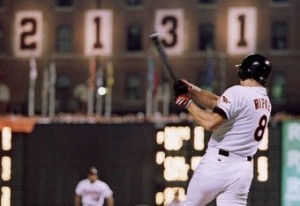
He responded in typical fashion, hitting a home run in the 4th inning. In a time when fans were disillusioned with millionaire ballpayers, they could relate to a guy who punched his time sheet every single day.
Nomo-mania and the Asian infusion into MLB was a top-5 story of this decade – but obviously it can’t pass Ripken up in 1995. Chan Ho Park and Nomo became household names in 1994/1995. Nomo became the first Japanese League player to play in MLB since the 1960’s. Park, the first Korean-born player in MLB history, actually beat him to the Majors, but didn’t become a full-time call-up until 1996. Nomo, meanwhile, started the All-Star game in 1996 and was second in the Cy Young voting that year – nearly matching the double that Fernando-mania had posted 15 years earlier.
1996 – Yankee return to prominence

The New York Yankees had the best record in the American League in 1994 when the strike ended the season. They made the playoffs after a 14-year drought in 1995 but lost in the first round to the Mariners. Finally, baseball’s most prominent franchise broke through in 1996, ending their longest championship drought since Babe Ruth played in Boston. They got by the defending champion Braves in the World Series, coming back from a 2-0 deficit.
1997 – Interleague Play
Baseball made a historic change in 1997 – one that many purists rue to this day. The idea of interleague play had roots much further back than people realize, and it was considered as far back as 1933 and looked at closely in 1956. But it wasn’t until 1997 that teams from the two leagues first played each other in regular season games. The first interleague game was played on June 12th, featuring a Giants victory over the Rangers at the Ballpark in Arlington.
1998 – Sosa and McGwire chase Maris

The overwhelming story of the 1998 season was the home run chase. After Mark McGwire and Ken Griffey, Jr. got close to Roger Maris in the ’97 season, both had 11 homers at the end of April, and McGwire had a whopping 27 through May. Sammy Sosa joined the party in June – he broke the all-time record with 20 home runs in a month. At the All-Star break, McGwire had 37, Griffey 35 and Sosa was at 33.
Griffey fell off in August, but Sosa and McGwire kept the pressure on. Both had 55 homers at the end of August; an average month would put both ahead of the Maris record of 61. McGwire had that average month in the first week. Hosting Sosa’s Cubs, Big Mac tied Maris on the 7th and then broke the record with his shortest homer of the year – a line drive that barely cleared the left field wall. McGwire ended with 70 to Sosa’s 66 – and we all know today what the real impetus was for this surge…
1999 – Yankees beat the Braves to stake claim as team of the decade
The 1999 season didn’t have quite the stories of the previous years, but it did feature a World Series with the best two teams of the decade. The Braves had won every division title of the decade except 1990, and the Yankees had won 2 World Championships. It wasn’t all that close, though, as the Yankees swept the Braves in 4 games.
Milestones
Strikeouts – Roger Clemens recorded his 3,000th strikeout in 1998.
Saves – Jeff Reardon passed Rollie Fingers as the all-time saves leader in 1992, and he was passed by Lee Smith shortly thereafter. Smith became the first pitcher with 400 saves at the end of 1993. John Franco joined him in 1999.
Wins – Nolan Ryan won his 300th game in 1990.
Home runs – Mark McGwire and Eddie Murray joined the 500 home run club.
Hits – Paul Molitor passed the 3,000 hit barrier in 1996, a year in which he led the league in hits. He’s the only player to do this, though Pete Rose and Derek Jeter have led the league in hits in a season after they notched #3,000. In addition to Molitor, George Brett, Robin Yount, Dave Winfield (all ’93), Eddie Murray (’95), Wade Boggs, and Tony Gwynn (both ’99) all reached the 3,000 hit mark in the 1990’s.
Stolen Bases – In addition to breaking Lou Brock’s career record, Rickey Henderson became the first player with over 1,000 stolen bases in 1992.
Runs – Henderson became the 4th player with 2,000 runs in his career toward the end of 1998.
Doubles – Brett and Molitor became the 9th and 10th players with over 600 doubles.
Perfect games – Dennis Martinez (1991), Kenny Rogers (1994) David Wells (1998) and Dave Cone (1999).
Records
- Ryan retired in 1993 with 5,714 strikeouts, a record that seems out of reach. He also ended his career with 2,795 walks, a more dubious all-time record.
- Ryan extended his own record to 7 no-hitters.
- Henderson passed Lou Brock’s career tally with his 939th steal in 1991.
- McGwire and Sosa both passed the Maris record of 61 homers in a season, with McGwire establishing the new mark of 70.
- Reardon passed Rollie Fingers’ save mark of 341, to be passed by Smith, who established the new career total of 478 when he retired in 1997.
- Bobby Thigpen obliterated Dave Righetti’s single season saves record of 46, when he saved 57 in 1990.
Awards
Barry Bonds won 3 MVP’s while Juan Gonzalez and Frank Thomas each won 2. Thomas and Bonds won awards in back-to-back years.
The Cy Young award was an oligopoly in the 1990’s. Greg Maddux won 4 consecutive Cy Young awards. Roger Clemens won 3 Cy Young awards, including his second time winning back-to-back. Tom Glavine, Pedro Martinez and Randy Johnson won 2 awards, with Martinez and Johnson becoming the 2nd and 3rd pitchers to win an award in each league.
Best Player/Pitcher in baseball
Throughout my write-ups, I tracked who I thought held the title as the current “Best Player (and Pitcher) in Baseball”. This was done by looking at looks at the players’ previous 5-and-3-year stretches as well as their most recent season. Here was my breakdown (Clemens was a carryover from the late 80’s, Henderson had passed Boggs in 1990):
 Best Player
Best Player
1990 – Rickey Henderson
1991-1998 – Barry Bonds
1999 – Jeff Bagwell
Best Pitcher
1987-1992 – Roger Clemens
1993-1998 – Greg Maddux
1999 – Pedro Martinez



























